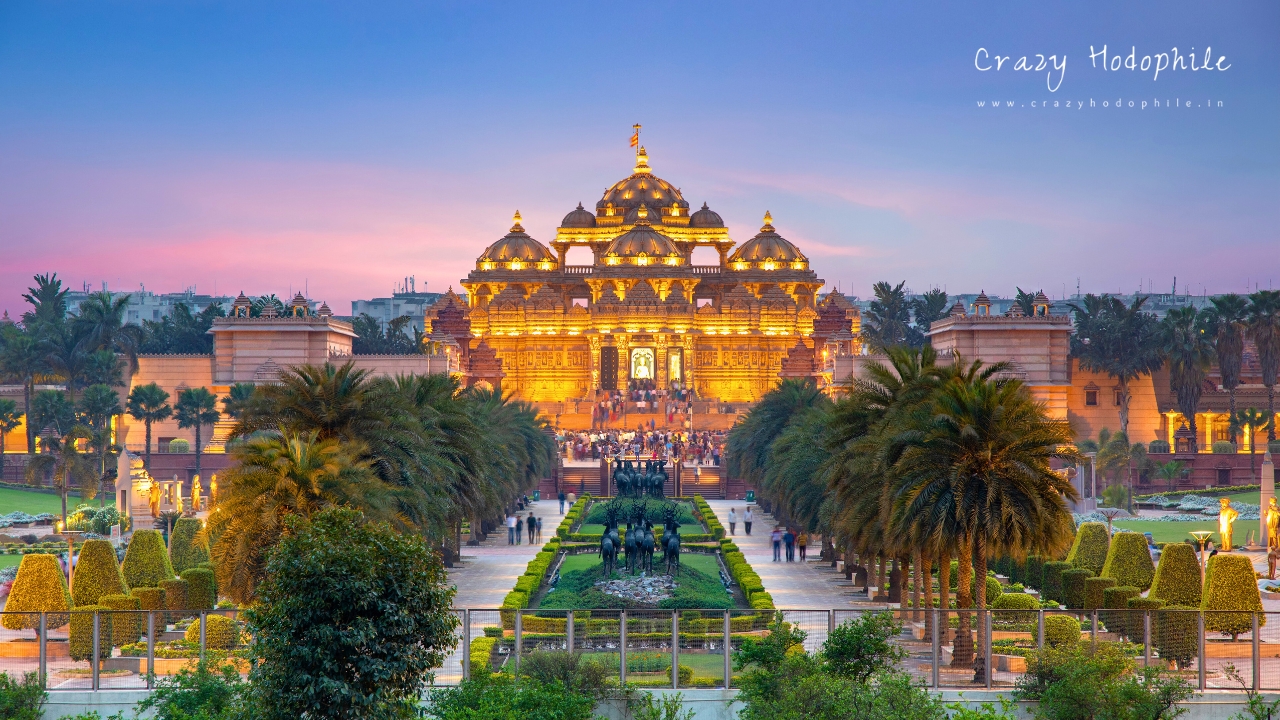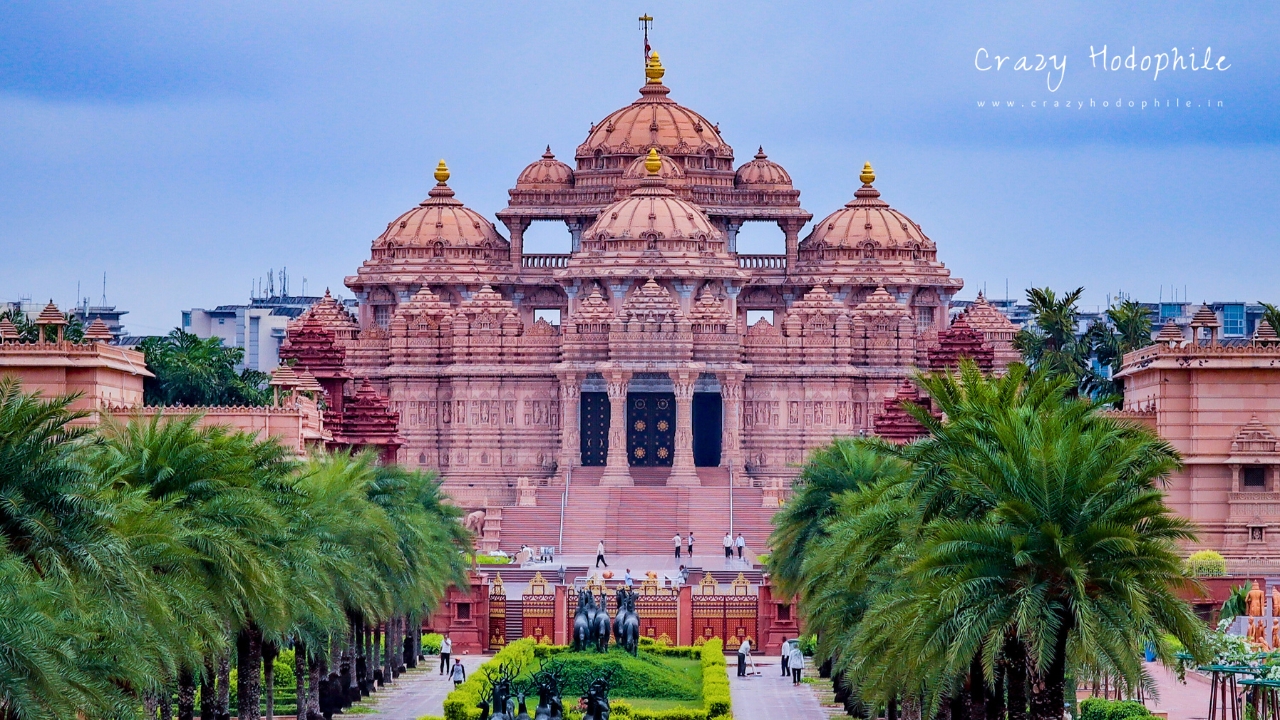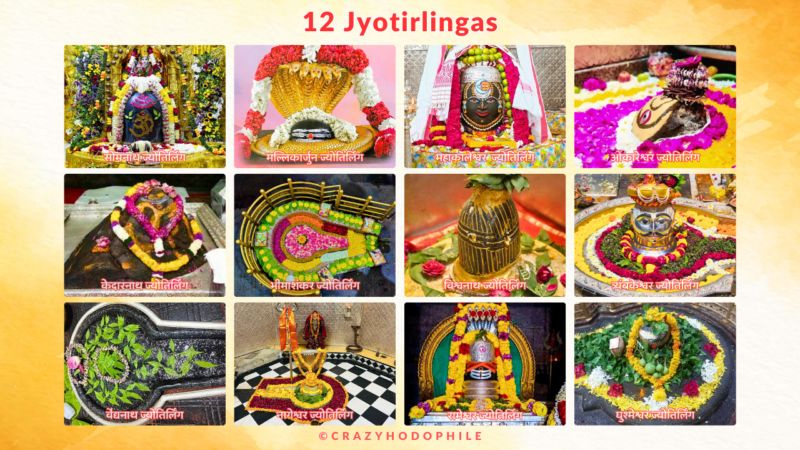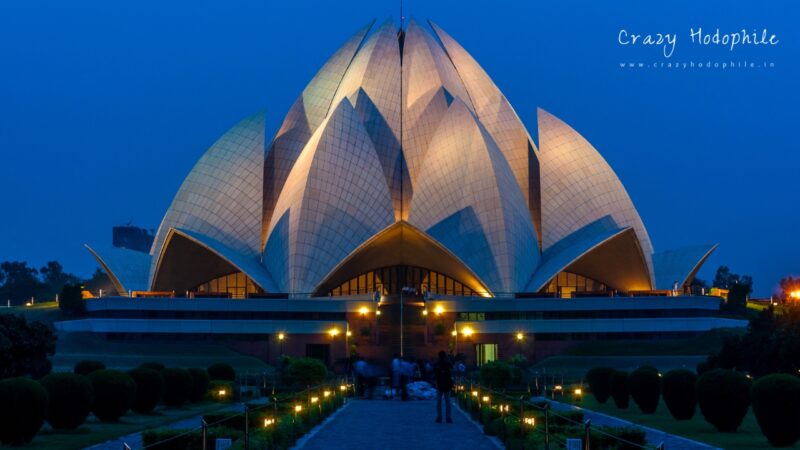Swaminarayan Akshardham Temple : Timings, Ticket Prices & Much More | Crazy Hodophile | 2025
Swaminarayan Akshardham, located in Delhi near the Noida border, is a Hindu temple and spiritual-cultural campus renowned for its grandeur. This architectural marvel draws millions of visitors from all over the world each year, leaving them in awe with its soothing and spiritual ambiance.
Table of Contents
Overview
Swaminarayan Akshardham, also often referred to as Akshardham Mandir or Akshardham Delhi, is spread over 100 acres on the banks of the Yamuna River. It was inaugurated on November 6, 2005, by Pramukh Swami Maharaj in the presence of Dr. A. P. J. Abdul Kalam, Dr. Manmohan Singh, and L.K Advani. The complex houses the main monument, a breathtakingly beautiful temple dedicated to Bhagwan Swaminarayan, along with several other attractions like exhibition halls, a musical fountain, and lush gardens.

Organization and Maintenance
The temple is managed by BAPS, a socio-spiritual organization with millions of followers worldwide. BAPS volunteers play a crucial role in the daily operations of the complex, ensuring its smooth functioning.
History of Akshardham
The inspiration behind Akshardham was HH Yogiji Maharaj, and the project was overseen by His Holiness Pramukh Swami Maharaj, the spiritual leader of the Bochasanwasi Shri Akshar Purushottam Swaminarayan Sanstha (BAPS). His vision was to create a place where people could connect with India’s ancient spiritual heritage and experience its profound values. The temple was designed by BAPS Swamis and Virendra Trivedi, a member of the Sompura family. The foundation stone was laid in July 2001. Reportedly, more than 30,000 volunteer hours went into making the complex, and over 8,000 artisans and volunteers from across India worked tirelessly to bring this vision to life.

Construction
The construction of Akshardham is a story of dedication, skill, and meticulous planning. The temple’s stunning pink sandstone was sourced from Rajasthan, while the exquisite marble was imported from Carrara, Italy. Following the principles of traditional Hindu architecture (Shilpa Shastras) to ensure the temple’s longevity, no ferrous metal was used in its construction, meaning there is no reliance on steel or concrete. The architectural design draws inspiration from the Māru-Gurjara style, blending intricate detailing with timeless elegance.
What to See in the Temple Premises
Gallery
Photo Courtesy: BAPS Sanstha
The Main Shrine
The centerpiece of Akshardham, this majestic temple stands 141 feet high, spans 316 feet wide, and 356 feet long. It’s adorned with 234 intricately carved pillars, nine ornate domes, 20 quadrangle spires, and 20,000 murtis (statues) of swamis, devotees, and acharyas. The Swaminarayan Akshardham temple boasts several remarkable architectural features:
- Garbhagruh (Sanctum Sanctorum): At the temple’s core lies the beautifully carved statue of Bhagwan Swaminarayan, accompanied by his spiritual successors: Gunatitanand Swami, Bhagatji Maharaj, Shastriji Maharaj, Yogiji Maharaj, and Pramukh Swami Maharaj.
- Mandapams: These grand halls, with their exquisitely carved pillars and ceilings, portray scenes from Hindu scriptures, immersing visitors in the rich tapestry of Hindu mythology and spirituality.
- Mandovar: The temple’s intricately carved external facade is a masterpiece of stonework. Standing 25 feet high and stretching 611 feet long. It features 200 sculpted stone figures of revered Hindu rishis, sadhus, devotees, acharyas, and avatars. This Mandovar is the largest and most intricate of its kind in India in the past eight centuries.
- Narayan Peeth: Situated on the upper plinth of the Akshardham temple, the Narayan Peeth provides a dedicated pathway for devotees to perform pradakshina, the revered Hindu tradition of circumambulating the temple clockwise.
- Gajendra Peeth: The lower plinth, known as the Gajendra Peeth, is adorned with 148 stone elephants. These elephants showcase scenes from Hindu legends and stories, adding to the temple’s narrative richness.
Abhishek Mandap
This is where the ritual bathing of a deity (abhishek) is performed for the fulfillment of one’s prayers. The worshiper pours water over the murti of Neelkanth Varni, symbolizing the youthful and ascetic form of Bhagwan Swaminarayan, amidst the chanting of prayers and mantras. This includes:
- Abhishek of Neelkanth: Visitors can perform the abhishek of the murti of Neelkanth Varni, symbolizing the youthful and ascetic form of Bhagwan Swaminarayan.
- Abhishek Ritual: The ritual begins with tying a sacred thread on the wrist, followed by a brief recital of Sanskrit shlokas. Each visitor or family bathes the murti with a small pot of sanctified water, creating a serene and spiritual atmosphere.
- Narayan Sarovar: Surrounding the mandir is the sacred Narayan Sarovar, a water body symbolizing purity and divinity. It contains water collected from 151 sacred lakes, rivers, and stepwells across India, representing the unity and sanctity of the nation’s water bodies. The outer walls of the mandir feature 108 bronze gaumukhs (cow faces), symbolizing the 108 names of God, from which holy water flows forth.
Exhibitions
Akshardham offers three captivating exhibitions that utilize cutting-edge technology to bring India’s rich heritage to life:
- Hall of Values (Sahajanand Darshan): An animatronic exhibition showcasing timeless values through inspiring stories from India’s past.
- Giant Screen Film (Neelkanth Darshan): This film offers a breathtaking journey across India with Neelkanth Varni, the young yogi who later became Bhagwan Swaminarayan.
- Cultural Boat Ride (Sanskruti Darshan): A 12-minute boat ride through 10,000 years of India’s glorious history, art, and culture.
Musical Fountain (Sahaj Anand Water Show)
Experience a mesmerizing 24-minute evening water show where synchronized water jets, vibrant multicolor lasers, and immersive surround sound come together to narrate an enchanting tale from the Kena Upanishad.
Thematic Gardens
Explore the serene beauty of two beautifully landscaped gardens:
- Bharat Upavan: Celebrating India’s rich heritage with lush greenery and bronze statues of historical icons.
- Yogi Hriday Kamal (Lotus-Shaped Garden): A unique lotus-shaped garden symbolizing purity and devotion, surrounded by vibrant greenery.
Visiting Information
Timings & Schedule
The Swaminarayan Akshardham Temple is open for devotees from Tuesday to Sunday.
- First Entry: 10:00 AM
- Last Entry: 6:30 PM
Here’s the detailed schedule for various sections of the temple:
- Main Shrine (Mandir): Open from 10:00 AM to 8:00 PM, with Aarti ceremonies at 10:30 AM and 6:00 PM.
- Abhishek Mandap: Open from 10:00 AM to 8:00 PM for darshan and puja.
- Exhibitions: The ticket counter is open from 11:00 AM to 6:00 PM.
- Sahaj Anand Water Show: Shows begin after sunset, with Maha Aarti held before the first show.
Tickets Details
Entry to the Akshardham complex and darshan at the mandir is free of charge. However, separate tickets are required for parking, exhibitions, and the Water Show. Tickets can be purchased on-site.
|
Exhibitions Ticket |
||
|
Adults (Age 12+) |
Seniors (Age 60+) |
Children (Age 4 – 11) |
|
₹ 255 |
₹ 205 |
₹ 155 |
|
Water Show Ticket |
||
|
Adults (Age 12+) |
Seniors (Age 60+) |
Children (Age 4 – 11) |
|
₹ 95 |
₹ 95 |
₹ 65 |
Note: Ticket prices are subject to change over time.
Tips for Visiting Akshardham
- Arrive Early: Plan to reach in the morning to explore the temple and its exhibits at ease. Exhibition entries are on a first-come, first-served basis, so arriving early helps avoid long queues.
- Avoid Prohibited Items: To ensure a quick and hassle-free security check, refrain from bringing restricted items such as electronic gadgets.
- Secure Belongings: If you bring prohibited items like phones or bags, make use of the free cloakroom facilities available at the temple.
- Carry Valid ID: Keep a government-issued ID handy, as proof of age or identity may be required.
- Use Public Transport: Parking can be limited during peak times; opt for public transport for a smoother travel experience.
- Allocate Sufficient Time: Set aside at least 4 to 5 hours for your visit. After darshan, you’ll need time to enjoy the exhibitions, gardens, and the mesmerizing water show.
Things to Take Care Of
- Footwear Policy: Shoes are not permitted inside the mandir. Please deposit them at the designated shoe house located near the entrance. Remember to collect your footwear before visiting the Gajendra Peeth.
- Dress Code: Visitors are required to dress modestly, ensuring that shoulders and knees are covered to respect the spiritual atmosphere.
- Prohibited Items: The following items are prohibited within the temple complex: mobile phones, cameras, other electronic devices, music players, drones, food, beverages, umbrellas, luggage, pets, and weapons.
- Behavior Etiquette: Maintain decorum throughout your visit by speaking softly and refraining from any form of shouting or inappropriate behavior. This ensures a peaceful environment for everyone.
Amenities Available Inside the Complex
- Drinking Water Stations: Free, filtered drinking water is conveniently available at various points throughout the complex.
- Food Court: The pure vegetarian food court, Premvati, offers a variety of cuisines. However, meal prices here may be slightly on the higher side.
- Souvenir Shop: Visitors can purchase souvenirs, books, and unique memorabilia from the temple’s gift center to remember their visit.
- Cloakroom: Free lockers are provided to store prohibited items like cameras and mobile phones. Note that deposited items must adhere to size restrictions.
- Wheelchair Accessibility: Complimentary wheelchairs are available for differently-abled visitors or those in need, ensuring accessibility for all.
- Parking: Paid parking facilities are available for visitors arriving by personal vehicles.
- Telephone Booths: Public telephone booths are located at the Visitors’ Center, Food Court, and Exhibition exits for your convenience.
- Photo Memory Booths: Two photo booths in the complex allow you to capture memorable moments as souvenirs. The cost of photos varies depending on size, and they can be collected at the Book and Gift Centre upon departure.
- ATM Facility: An ATM is available at the Visitors’ Center for any immediate cash needs.
- Washrooms: Clean and well-maintained washrooms are situated throughout the complex for visitor convenience.
How to Reach
Swaminarayan Akshardham Temple is located in Pandav Nagar, New Delhi, and is easily accessible by various modes of transport:
By Metro
The nearest metro station is Akshardham Metro Station on the Blue Line, which is just 350 meters from the temple.
By Bus
Delhi Transport Corporation (DTC) buses and private buses operate regularly to Akshardham. The nearest bus stop is Pusta Crossing, Akshardham Mandir.
By Train
If you’re arriving in Delhi by train, Akshardham is easily accessible from major railway stations:
- New Delhi Railway Station: Approximately 11 km away. You can hire a cab or take the metro.
- Hazrat Nizamuddin Railway Station: Approximately 6 km away, easily accessible by cab, auto-rickshaw, or metro.
By Air
The nearest airport is Indira Gandhi International Airport (IATA: DEL), about 20 km from Akshardham Temple. Visitors can book a prepaid taxi or app-based cab service to reach the temple directly. Alternatively, take the Airport Express Metro Line to the Akshardham Metro Station.
Location Map for Swaminarayan Akshardham
Nearby Temples
- Radha Krishna Mandir (2 km): A vibrant temple celebrating the divine love of Radha and Krishna, often featuring lively kirtans and festivals.
- Prachin Shivalya Mandir (6 km): This ancient temple dedicated to Lord Shiva is known for its intricate carvings and peaceful atmosphere.
- Shri Kalkaji Mandir (8 km): This renowned Hindu temple is dedicated to Goddess Kali, a powerful manifestation of Shakti. It attracts devotees seeking blessings for strength and protection.
- Lotus Temple (10 km): A Baha’i House of Worship known for its distinctive lotus-shaped architecture. It welcomes people of all faiths and backgrounds for prayer and reflection.
- ISKCON Temple, East of Kailash (14 km): This prominent ISKCON temple is dedicated to Lord Krishna.
Nearby Attractions
- India Gate (9 km): A majestic archway commemorating Indian soldiers who lost their lives in World War I. It’s surrounded by expansive lawns, making it a popular spot for picnics and strolls.
- National Zoological Park (10 km): Commonly known as the Delhi Zoo, this sprawling zoo houses a diverse collection of animals from around the world. It’s a great place for families and wildlife enthusiasts.
- Humayun’s Tomb (10 km): A UNESCO World Heritage site, Humayun’s Tomb is a 16th-century Mughal-era structure.
- Red Fort (10 km): Another UNESCO World Heritage Site, the Red Fort served as the main residence of Mughal emperors for nearly 200 years.
- Amrit Udyan (12 km): Formerly the Mughal Gardens, this beautifully landscaped garden within the Rashtrapati Bhavan complex is open to the public for a limited time each year.
Conclusion
Swaminarayan Akshardham is more than just a temple; it’s a cultural complex that showcases the best of India’s art, architecture, and spiritual heritage. A visit to Akshardham is a truly enriching experience, leaving you with a sense of peace, wonder, and inspiration. Whether you’re a spiritual seeker, an art enthusiast, or a history buff, Akshardham has something to offer everyone. Plan your visit today and immerse yourself in the beauty and grandeur of this magnificent monument.
Related External References:
- Akshardham Shilnyas Vidhi (10 Nov 2000)
- First Stone Laying Ceremony at Akshardham (5 July 2001)
- Vedic Murti-Pratishtha rituals at Swaminarayan Akshardham (6 Nov 2005)
- Delhi’s Akshardham is the world’s largest temple (The Guinness Book of World Records) (27 Dec 2007)
















Excellant work and what a hard work also. Hats off to you dear.
Thank you so much. I appreciate your feedback!